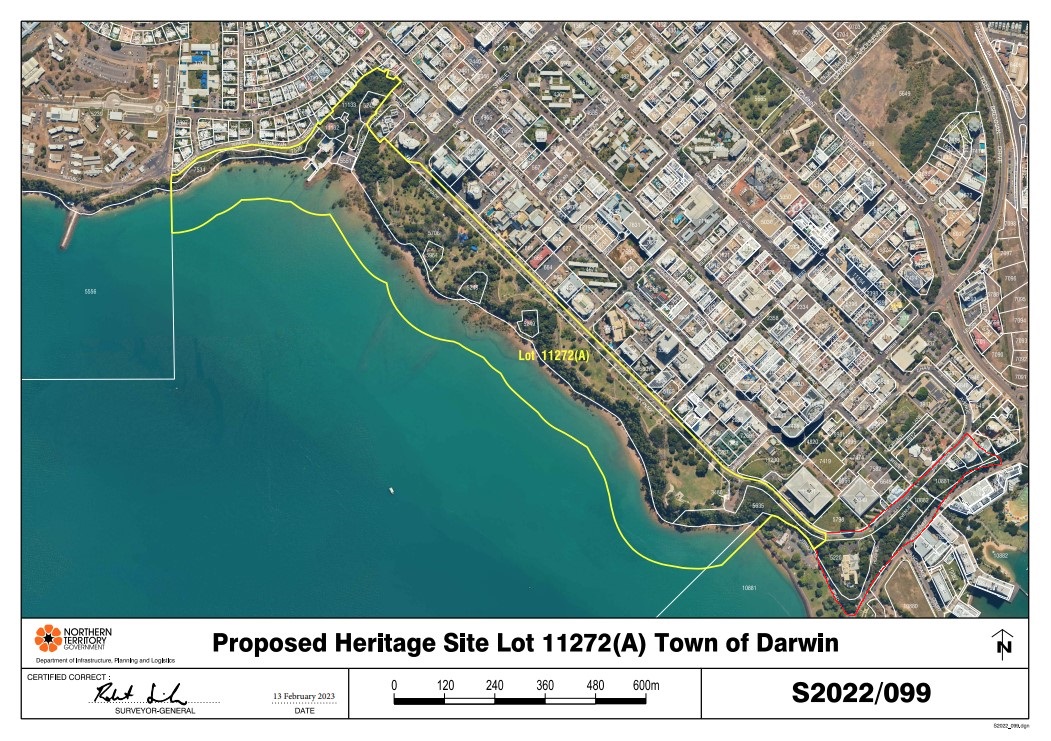Update 18/12/2024
Department of Lands, Planning and Environment
Heritage Council speaks to the Supreme Court decision on the Darwin Esplanade
17 December 2024
Background
On 3 December 2021 the Heritage Council accepted a nomination from a member of the public for the Darwin Esplanade to be a protected heritage place under the Heritage Act 2011.
The Heritage Council assessed the nomination against the criteria established by the Heritage Act 2011. The Council determined that the Esplanade is of heritage significance and commenced consultation on whether it should be heritage listed.
When the Heritage Council determines a place to be of heritage significance and begins consultation, the Heritage Act requires the Minister for Heritage to provisionally declare that place to be a Heritage Place to afford it interim protection. This is what occurred with the Esplanade.
In May 2023 the City of Darwin commenced legal proceedings in the Supreme Court, challenging the decisions of the Heritage Council and Minister on 7 grounds.
On 15 November 2024 Justice Huntingford found in favour of the City of Darwin on 2 of the 7 grounds. The Judge found that the Heritage Council was obliged to afford the City of Darwin, as a landowner, the right to be heard before making a decision about the heritage significance of the Esplanade.
On the basis of the findings Justice Huntingford has made orders to set aside the Heritage Council’s earlier decision that the Esplanade is of heritage significance and the provisional declaration of the Esplanade as a Heritage Place.
Comments from Heritage Council Chairperson Randle Walker
The Heritage Council accepts the findings of the Court.
The original nomination of the Esplanade stands.
In February 2025 the Heritage Council will restart the assessment of the Esplanade and write to landowners and occupiers including the City of Darwin seeking submissions. Before deciding whether the Esplanade is of heritage significance the Heritage Council will consider these submissions.
If the Heritage Council finds the Esplanade is of heritage significance, it is then required to consult more broadly on the nomination and the Minister must provisionally declare the Esplanade a Heritage Place.
The Heritage Council would then provide a recommendation to the Minister on whether the Esplanade should be permanently declared a Heritage Place.
ENDS.
Media contact: 0455 824 926
If you are concerned about the Heritage Listing of the Esplanade, sign the open letter here: Open letter to City of Darwin
Download and print out the flyer with the open letter QR code here: 2024_05_The_Esplanade_is_most_important_QR.pdf
STATEMENT OF HERITAGE VALUE
The Esplanade is a large area of public open space bordering the Darwin Central Business District and overlooking Darwin Harbour. Aboriginal sacred sites and a number of historical features and significant memorials are located across landscaped, open parkland fringed by remnant rainforest.
The Esplanade is a legacy of the original 1869 Palmerston (Darwin) town plan and echoes town planning principles imported from South Australia. It represents a colonial cultural treatment of the landscape through the provision of planned, public space. Maintaining public rights to this green space has been the focus of continual public advocacy.
Lands encompassed by The Esplanade are of cultural significance to Larrakia Aboriginal people because of the presence of the Damoe-ra sacred site which is represented by a freshwater spring created by the actions of a Dreaming ancestor, the doemgilla trevally fish. The Larrakia lived on Lameroo Beach and The Esplanade until the powers of the Aboriginals Act 1910 saw them relocated to the Kahlin Aboriginal Compound in 1912. This site is therefore associated with the increased marginalisation of Aboriginal people from the town at that time.
The Esplanade continues to have high aesthetic significance and is a landmark feature of the city. The monsoon rainforest along the escarpment made for a memorable entry for boats entering the harbour and reinforced the identity of the tropical, harbour town. The remnant rainforest is one of a small number of important rainforest patches on the Darwin Peninsular which act interdependently to maintain biodiversity.
While the extent of The Esplanade has changed over time, it has remained true to purpose for more than one hundred and fifty years. Its multi-layered history gives it a unique place in the social and cultural history of Darwin. The fresh water springs that sustained the Larrakia people were appropriated as the earliest water sources for the town. Fruit and vegetable gardens planted around the springs at Doctor’s Gully were taken over by Chinese people, who worked them for many decades. ‘Greek Town’ was established above the Gully. Popular swimming baths were developed at Lameroo Beach in 1921.
Between 1882 and the 1950s, the Darwin Oval was the centre for sporting activity in the town with the earliest cricket and Australian Rules football games played there. The Oval has been the destination point for military, May Day and Bougainvillea parades and has been the location for significant events like Royal visits. Across time The Esplanade has been a meeting and gathering place for cross-cultural encounters, picnics, celebrations, music and cultural festivals, protests and political agitation.
The Esplanade was occupied by the military during World War II and the anti-aircraft guns positioned there are claimed to be the first to fire at attacking Japanese aircraft on 19 February 1942. Further military infrastructure developed on The Esplanade include five Naval Oil Tanks and the RAAF Catalina base at Doctor’s Gully, remnants of which still exist. The relocation of the Cenotaph to The Esplanade in 1990, together with the USS Peary Memorial, the ANZAC Centenary Memorial Garden and Walk, and the Civilians Memorial Entrance has seen The Esplanade become the major site for official military commemorations and tourist visitation. They serve as poignant reminders of the sacrifices made during wartime and of Darwin’s important role in World War II.

